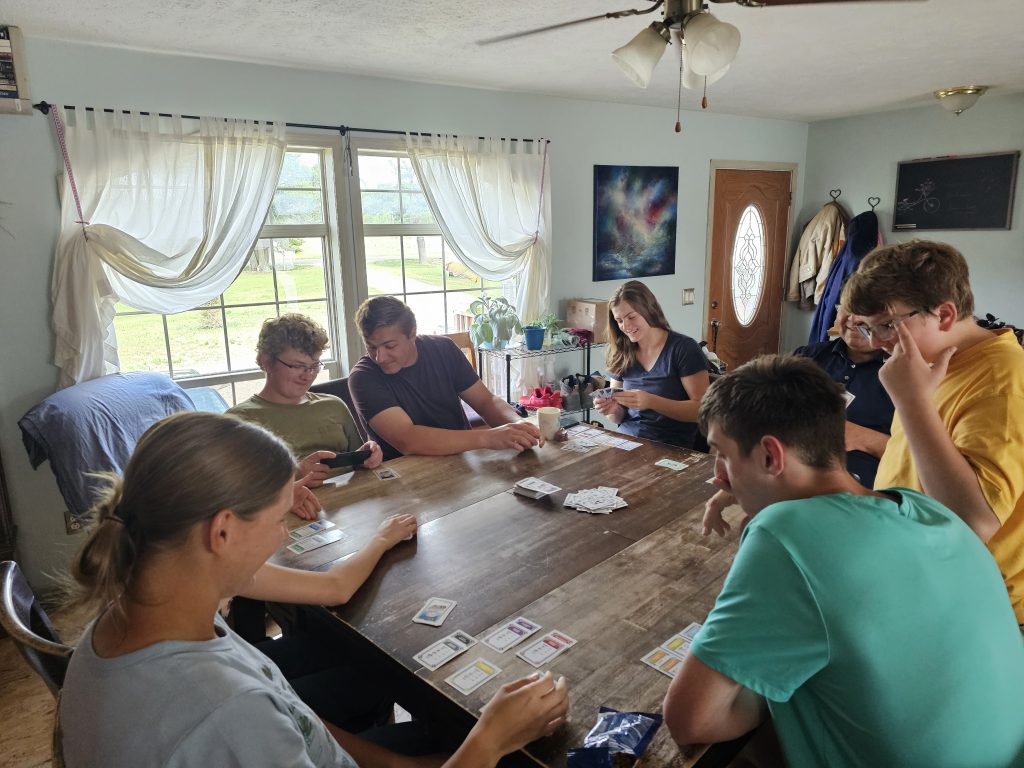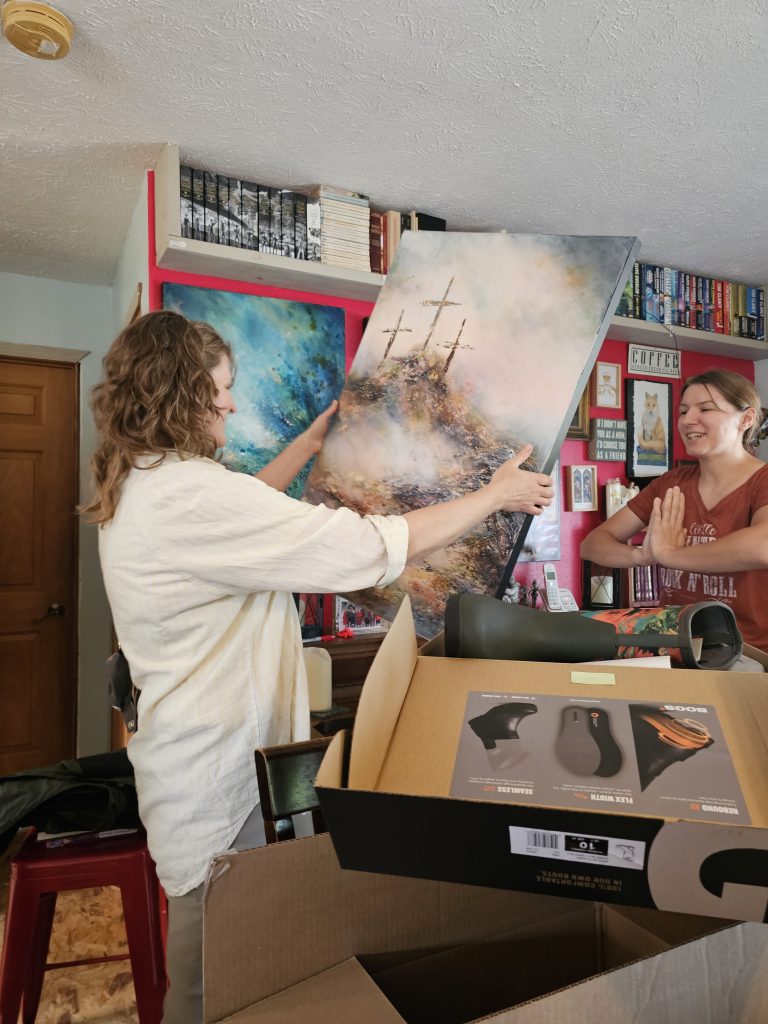How the Arends family settled in
The Catholic Church’s calendar has established a yearly rhythm for the faithful for centuries. The Arends family, from New Lisbon, has been growing in their knowledge and appreciation of this rhythm, learning to reflect it into their daily family life.
But how do we live the rhythm of a liturgical year once Mass ends? What does that look like, and why is it important?
Liturgical living is about making the Church’s liturgy and feasts tangible and accessible within family life. This can be achieved through activities such as praying, reading, cooking, crafting and decorating. It keeps the life of the Church alive at home, guiding families to practice and embody the Faith each day. Many Catholics overlook this opportunity, but embracing it enriches daily life with the beauty and depth of the Catholic Tradition, fostering spiritual growth and strengthening family bonds.
Meeting Through Providence
About 10 years ago, shortly after the death of her first husband and the father of her children, Jean Arends continued to run the lawn care business they had built together. While mowing a regular customer’s yard, a neighbor stepped outside and asked if she could mow his lawn as well when she had time. She agreed—and returned just an hour later, much to his surprise.
That neighbor was Loren Arends. Struck by Jean’s work ethic and zest for life, he asked her to dinner more than once. But with a business to run and 10 children to raise, she didn’t have much time to spare. Still, in God’s providence, their paths drew closer—and eventually, He brought them together.

Jean especially recalls the long drives to Chicago to pick up her oldest daughter, Jamie, from college—often with Loren riding along. During those hours on the road, they had many conversations about her Catholic faith.
Loren had been raised Lutheran, but as his relationship with Jean deepened, he began attending Mass with her family at St. Francis Parish in Necedah and meeting with their pastor at the time, Father Joseph Redfern. Moved by what he encountered, Loren expressed a desire to join the Church and began the Rite of Christian Initiation for Adults (RCIA) process.
Faith on the Farm
Jean and Loren were married on Dec. 15, 2018, at St. Paul Parish in New Lisbon. The family settled on a 100-year-old former dairy farm, now a working ranch. There, they live in harmony with the natural rhythms of the seasons—planting, harvesting and caring for their pasture-raised chickens, lambs and dairy cattle.
“The ranch is God’s blessing, as we are always reminded of His ever-presence through the weather, the health of the animals and the produce we receive from our garden,” Jean says.
It has been a fitting place for the family to spread their wings and hone their gifts and talents. Nine of Jean’s children, now ages 13 to 29, continue to live and work on the 20-acre ranch.
When Jean was starting anew, she focused on building a future for herself and her 10 children with Catholicism firmly at the center. Seeking new ways to weave that faith into daily life, she found inspiration in author Kendra Tierney’s writing and picked up “Building the Benedict Option,” a practical guide for Christians looking to cultivate communities of prayer, fellowship and evangelization in their everyday surroundings.

The book deepened Jean’s interest in liturgical living and introduced her to the idea of creating a domestic church—a Christian family that, through its daily life and love, reflects the relationship between Christ and His Church. In this space, faith is nurtured, and family bonds are strengthened through a shared relationship with God.
From there, one book led to another and then another. Jean’s stack of spiritual must-reads on liturgical living continued to grow, and her family life began to reflect the richness of what she was learning. Her reading also became an essential resource for Loren’s questions about the Faith during his RCIA journey. Jean’s enthusiasm for embracing the rhythms of the Church was contagious, and her family took notice.
Seasons, Saints and S’mores
She started small, building on traditions and routines her family already practiced—like mealtime prayer. Each month, the Catholic Church celebrates a particular devotion: May honors the Blessed Virgin Mary, June is dedicated to the Sacred Heart, November focuses on remembering the holy souls in purgatory, and so on. To align with these devotions, Jean adds a short, complimentary prayer at meals, a simple gesture that helps turn her family’s focus on the Church’s liturgical life. Her children have come to look forward to it with excitement.
The Arends learned to decorate their home for the current liturgical season, reflecting the corresponding colors, symbols and saints. Evening meals occasionally began to include ethnic dishes to commemorate the saint of the day’s country of origin. Extra treats and activities became part of their routine, like coming together on June 22 to celebrate St. Thomas Moore with s’mores. They ate by candlelight on Dec. 13 in honor of St. Lucy. And when her kids would ask about the new additions, Jean took the opportunity to teach them about the many and varied saints and feasts we celebrate as Catholics, enriching our connection to the Faith and the Church. She always invited them to continue to do their own research about the holy men and women the Church gives us to look up to. Many did. As they grew and began searching for their place in the body of Christ, their lives became more open to all these holy examples.
Faith That Grows Together
In conversation one day, Jean’s 28-year-old daughter, Michaela, wisely put into words something that had been on Jean’s own heart: “Something is missing when it comes to educating in the Faith.” She came to see that there was this “missing component” that gets overlooked in catechesis for many Catholics. “Just because you’re cradle-Catholic, teachers of the Faith just assumed you knew [this or that point of the Faith,] but if it wasn’t taught to you, if it was never mentioned to you, and your parents never told you or explained something to you, you’re missing that tiny little piece.” Those pieces add up. You start to feel that something is missing.
Michaela was fortunate enough to have had an upbringing where those pieces were explained or explored together as a family, should any questions arise. But she has enthusiastically embraced her desire to share the “missing pieces” in passing on the Faith to others who may still be searching and turned it into a podcast aptly named “Little Ways.” It is a thoughtful, accessible and eloquent commentary on all the little aspects of the practice of the Faith.
As Michaela explains, “‘Little Ways’ invites listeners to discover the joy and fulfillment of living a faith-centered life. Each episode explores simple, practical ways to live out Catholic teachings—through daily prayer, acts of service and small sacrifices offered for God’s glory.
Michaela shares that simply looking around her home reveals stewardship in action: her youngest siblings expressing grace through dance; her sisters, Jamie and Kiara, sharing beauty through faith-inspired art; her brothers applying their mechanical skills to design, rebuild and repair; and her sister Rebekah managing the daily operations of the ranch.
Everyone in the Arends family plays an essential role in keeping things running smoothly. Each child has embraced the Faith and is actively building a life rooted in purpose. Through welding, art, photography, graphic design, agriculture and good old-fashioned hard work, they are integrating the Faith into all they do—witnessing to what we believe and celebrate as Catholics.
By embracing their roles and living together in harmony with the rhythms of the liturgical year, the Arends family embodies what they’ve discovered and reflect it vibrantly in the world through their work and the unique persons God created them to be. As we see in the example of the saints, and in the words of St. Catherine of Siena: “Be who God meant you to be, and you will set the world on fire.”
Story By Amy Eichsteadt
Published in the Fall 2025 Edition of Catholic Life Magazine

